Graham W. Taylor
A multi-modal dataset for insect biodiversity with imagery and DNA at the trap and individual level
Jul 09, 2025Abstract:Insects comprise millions of species, many experiencing severe population declines under environmental and habitat changes. High-throughput approaches are crucial for accelerating our understanding of insect diversity, with DNA barcoding and high-resolution imaging showing strong potential for automatic taxonomic classification. However, most image-based approaches rely on individual specimen data, unlike the unsorted bulk samples collected in large-scale ecological surveys. We present the Mixed Arthropod Sample Segmentation and Identification (MassID45) dataset for training automatic classifiers of bulk insect samples. It uniquely combines molecular and imaging data at both the unsorted sample level and the full set of individual specimens. Human annotators, supported by an AI-assisted tool, performed two tasks on bulk images: creating segmentation masks around each individual arthropod and assigning taxonomic labels to over 17 000 specimens. Combining the taxonomic resolution of DNA barcodes with precise abundance estimates of bulk images holds great potential for rapid, large-scale characterization of insect communities. This dataset pushes the boundaries of tiny object detection and instance segmentation, fostering innovation in both ecological and machine learning research.
Taxonomic Reasoning for Rare Arthropods: Combining Dense Image Captioning and RAG for Interpretable Classification
Mar 13, 2025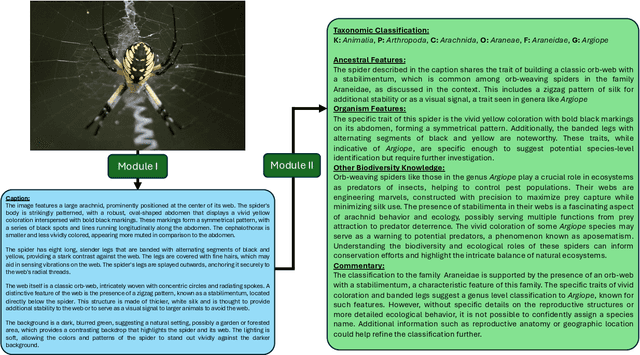
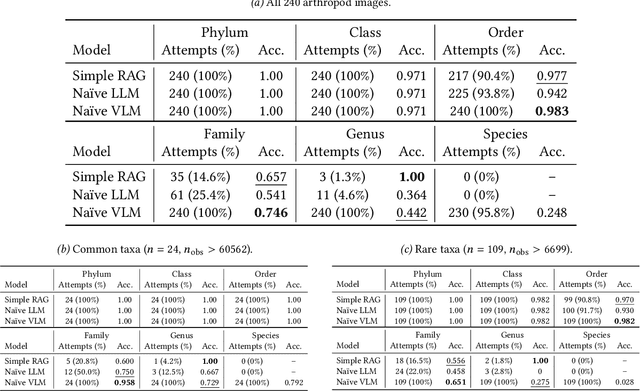
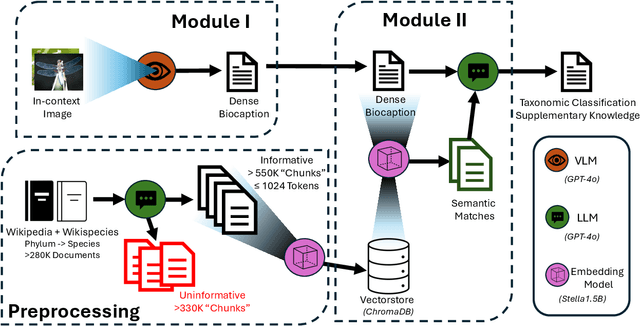
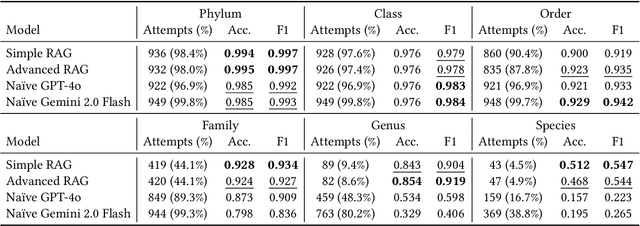
Abstract:In the context of pressing climate change challenges and the significant biodiversity loss among arthropods, automated taxonomic classification from organismal images is a subject of intense research. However, traditional AI pipelines based on deep neural visual architectures such as CNNs or ViTs face limitations such as degraded performance on the long-tail of classes and the inability to reason about their predictions. We integrate image captioning and retrieval-augmented generation (RAG) with large language models (LLMs) to enhance biodiversity monitoring, showing particular promise for characterizing rare and unknown arthropod species. While a naive Vision-Language Model (VLM) excels in classifying images of common species, the RAG model enables classification of rarer taxa by matching explicit textual descriptions of taxonomic features to contextual biodiversity text data from external sources. The RAG model shows promise in reducing overconfidence and enhancing accuracy relative to naive LLMs, suggesting its viability in capturing the nuances of taxonomic hierarchy, particularly at the challenging family and genus levels. Our findings highlight the potential for modern vision-language AI pipelines to support biodiversity conservation initiatives, emphasizing the role of comprehensive data curation and collaboration with citizen science platforms to improve species identification, unknown species characterization and ultimately inform conservation strategies.
Enhancing DNA Foundation Models to Address Masking Inefficiencies
Feb 25, 2025Abstract:Masked language modelling (MLM) as a pretraining objective has been widely adopted in genomic sequence modelling. While pretrained models can successfully serve as encoders for various downstream tasks, the distribution shift between pretraining and inference detrimentally impacts performance, as the pretraining task is to map [MASK] tokens to predictions, yet the [MASK] is absent during downstream applications. This means the encoder does not prioritize its encodings of non-[MASK] tokens, and expends parameters and compute on work only relevant to the MLM task, despite this being irrelevant at deployment time. In this work, we propose a modified encoder-decoder architecture based on the masked autoencoder framework, designed to address this inefficiency within a BERT-based transformer. We empirically show that the resulting mismatch is particularly detrimental in genomic pipelines where models are often used for feature extraction without fine-tuning. We evaluate our approach on the BIOSCAN-5M dataset, comprising over 2 million unique DNA barcodes. We achieve substantial performance gains in both closed-world and open-world classification tasks when compared against causal models and bidirectional architectures pretrained with MLM tasks.
BarcodeMamba: State Space Models for Biodiversity Analysis
Dec 15, 2024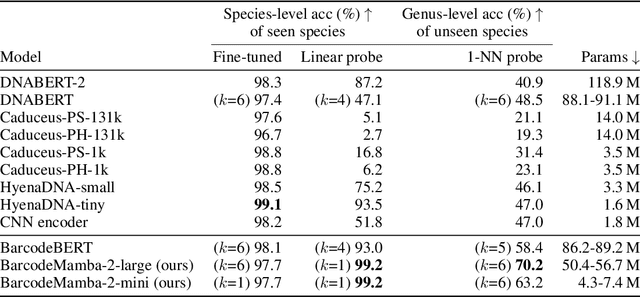



Abstract:DNA barcodes are crucial in biodiversity analysis for building automatic identification systems that recognize known species and discover unseen species. Unlike human genome modeling, barcode-based invertebrate identification poses challenges in the vast diversity of species and taxonomic complexity. Among Transformer-based foundation models, BarcodeBERT excelled in species-level identification of invertebrates, highlighting the effectiveness of self-supervised pretraining on barcode-specific datasets. Recently, structured state space models (SSMs) have emerged, with a time complexity that scales sub-quadratically with the context length. SSMs provide an efficient parameterization of sequence modeling relative to attention-based architectures. Given the success of Mamba and Mamba-2 in natural language, we designed BarcodeMamba, a performant and efficient foundation model for DNA barcodes in biodiversity analysis. We conducted a comprehensive ablation study on the impacts of self-supervised training and tokenization methods, and compared both versions of Mamba layers in terms of expressiveness and their capacity to identify "unseen" species held back from training. Our study shows that BarcodeMamba has better performance than BarcodeBERT even when using only 8.3% as many parameters, and improves accuracy to 99.2% on species-level accuracy in linear probing without fine-tuning for "seen" species. In our scaling study, BarcodeMamba with 63.6% of BarcodeBERT's parameters achieved 70.2% genus-level accuracy in 1-nearest neighbor (1-NN) probing for unseen species. The code repository to reproduce our experiments is available at https://github.com/bioscan-ml/BarcodeMamba.
Food for thought: How can machine learning help better predict and understand changes in food prices?
Dec 09, 2024Abstract:In this work, we address a lack of systematic understanding of fluctuations in food affordability in Canada. Canada's Food Price Report (CPFR) is an annual publication that predicts food inflation over the next calendar year. The published predictions are a collaborative effort between forecasting teams that each employ their own approach at Canadian Universities: Dalhousie University, the University of British Columbia, the University of Saskatchewan, and the University of Guelph/Vector Institute. While the University of Guelph/Vector Institute forecasting team has leveraged machine learning (ML) in previous reports, the most recent editions (2024--2025) have also included a human-in-the-loop approach. For the 2025 report, this focus was expanded to evaluate several different data-centric approaches to improve forecast accuracy. In this study, we evaluate how different types of forecasting models perform when estimating food price fluctuations. We also examine the sensitivity of models that curate time series data representing key factors in food pricing.
Agglomerative Token Clustering
Sep 18, 2024Abstract:We present Agglomerative Token Clustering (ATC), a novel token merging method that consistently outperforms previous token merging and pruning methods across image classification, image synthesis, and object detection & segmentation tasks. ATC merges clusters through bottom-up hierarchical clustering, without the introduction of extra learnable parameters. We find that ATC achieves state-of-the-art performance across all tasks, and can even perform on par with prior state-of-the-art when applied off-the-shelf, i.e. without fine-tuning. ATC is particularly effective when applied with low keep rates, where only a small fraction of tokens are kept and retaining task performance is especially difficult.
Open-Vocabulary Temporal Action Localization using Multimodal Guidance
Jun 21, 2024Abstract:Open-Vocabulary Temporal Action Localization (OVTAL) enables a model to recognize any desired action category in videos without the need to explicitly curate training data for all categories. However, this flexibility poses significant challenges, as the model must recognize not only the action categories seen during training but also novel categories specified at inference. Unlike standard temporal action localization, where training and test categories are predetermined, OVTAL requires understanding contextual cues that reveal the semantics of novel categories. To address these challenges, we introduce OVFormer, a novel open-vocabulary framework extending ActionFormer with three key contributions. First, we employ task-specific prompts as input to a large language model to obtain rich class-specific descriptions for action categories. Second, we introduce a cross-attention mechanism to learn the alignment between class representations and frame-level video features, facilitating the multimodal guided features. Third, we propose a two-stage training strategy which includes training with a larger vocabulary dataset and finetuning to downstream data to generalize to novel categories. OVFormer extends existing TAL methods to open-vocabulary settings. Comprehensive evaluations on the THUMOS14 and ActivityNet-1.3 benchmarks demonstrate the effectiveness of our method. Code and pretrained models will be publicly released.
BIOSCAN-5M: A Multimodal Dataset for Insect Biodiversity
Jun 18, 2024



Abstract:As part of an ongoing worldwide effort to comprehend and monitor insect biodiversity, this paper presents the BIOSCAN-5M Insect dataset to the machine learning community and establish several benchmark tasks. BIOSCAN-5M is a comprehensive dataset containing multi-modal information for over 5 million insect specimens, and it significantly expands existing image-based biological datasets by including taxonomic labels, raw nucleotide barcode sequences, assigned barcode index numbers, and geographical information. We propose three benchmark experiments to demonstrate the impact of the multi-modal data types on the classification and clustering accuracy. First, we pretrain a masked language model on the DNA barcode sequences of the \mbox{BIOSCAN-5M} dataset, and demonstrate the impact of using this large reference library on species- and genus-level classification performance. Second, we propose a zero-shot transfer learning task applied to images and DNA barcodes to cluster feature embeddings obtained from self-supervised learning, to investigate whether meaningful clusters can be derived from these representation embeddings. Third, we benchmark multi-modality by performing contrastive learning on DNA barcodes, image data, and taxonomic information. This yields a general shared embedding space enabling taxonomic classification using multiple types of information and modalities. The code repository of the BIOSCAN-5M Insect dataset is available at {\url{https://github.com/zahrag/BIOSCAN-5M}}
An Empirical Study into Clustering of Unseen Datasets with Self-Supervised Encoders
Jun 04, 2024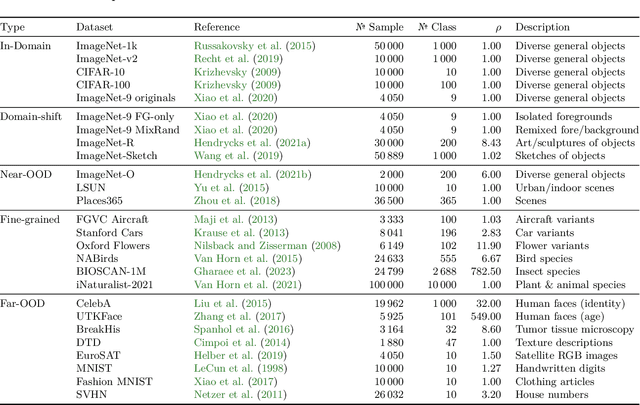
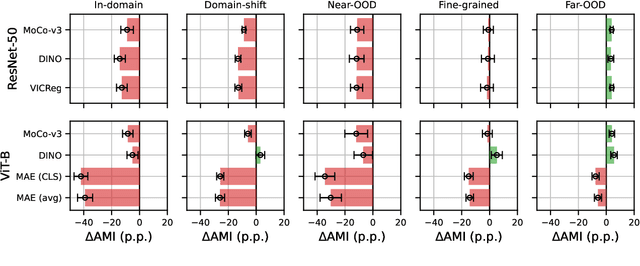
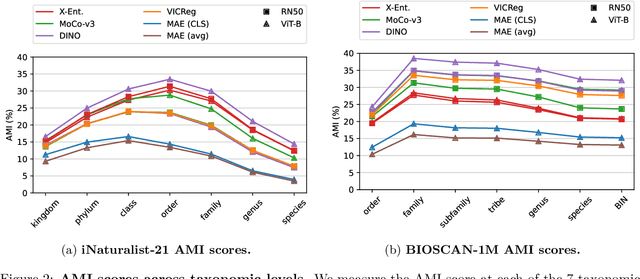
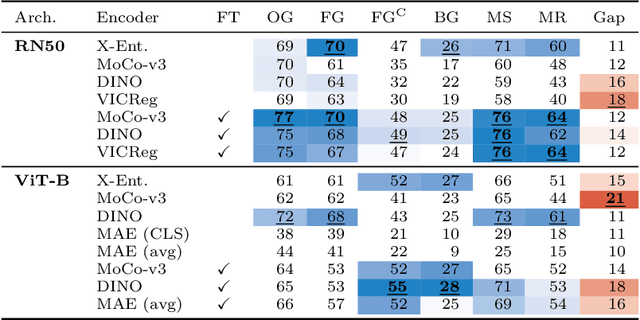
Abstract:Can pretrained models generalize to new datasets without any retraining? We deploy pretrained image models on datasets they were not trained for, and investigate whether their embeddings form meaningful clusters. Our suite of benchmarking experiments use encoders pretrained solely on ImageNet-1k with either supervised or self-supervised training techniques, deployed on image datasets that were not seen during training, and clustered with conventional clustering algorithms. This evaluation provides new insights into the embeddings of self-supervised models, which prioritize different features to supervised models. Supervised encoders typically offer more utility than SSL encoders within the training domain, and vice-versa far outside of it, however, fine-tuned encoders demonstrate the opposite trend. Clustering provides a way to evaluate the utility of self-supervised learned representations orthogonal to existing methods such as kNN. Additionally, we find the silhouette score when measured in a UMAP-reduced space is highly correlated with clustering performance, and can therefore be used as a proxy for clustering performance on data with no ground truth labels. Our code implementation is available at \url{https://github.com/scottclowe/zs-ssl-clustering/}.
Adapting Conformal Prediction to Distribution Shifts Without Labels
Jun 03, 2024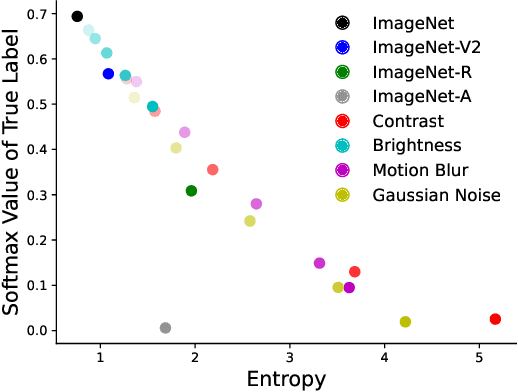

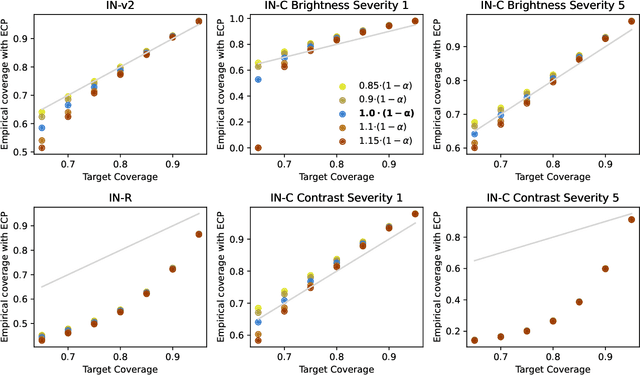

Abstract:Conformal prediction (CP) enables machine learning models to output prediction sets with guaranteed coverage rate, assuming exchangeable data. Unfortunately, the exchangeability assumption is frequently violated due to distribution shifts in practice, and the challenge is often compounded by the lack of ground truth labels at test time. Focusing on classification in this paper, our goal is to improve the quality of CP-generated prediction sets using only unlabeled data from the test domain. This is achieved by two new methods called ECP and EACP, that adjust the score function in CP according to the base model's uncertainty on the unlabeled test data. Through extensive experiments on a number of large-scale datasets and neural network architectures, we show that our methods provide consistent improvement over existing baselines and nearly match the performance of supervised algorithms.
 Add to Chrome
Add to Chrome Add to Firefox
Add to Firefox Add to Edge
Add to Edge